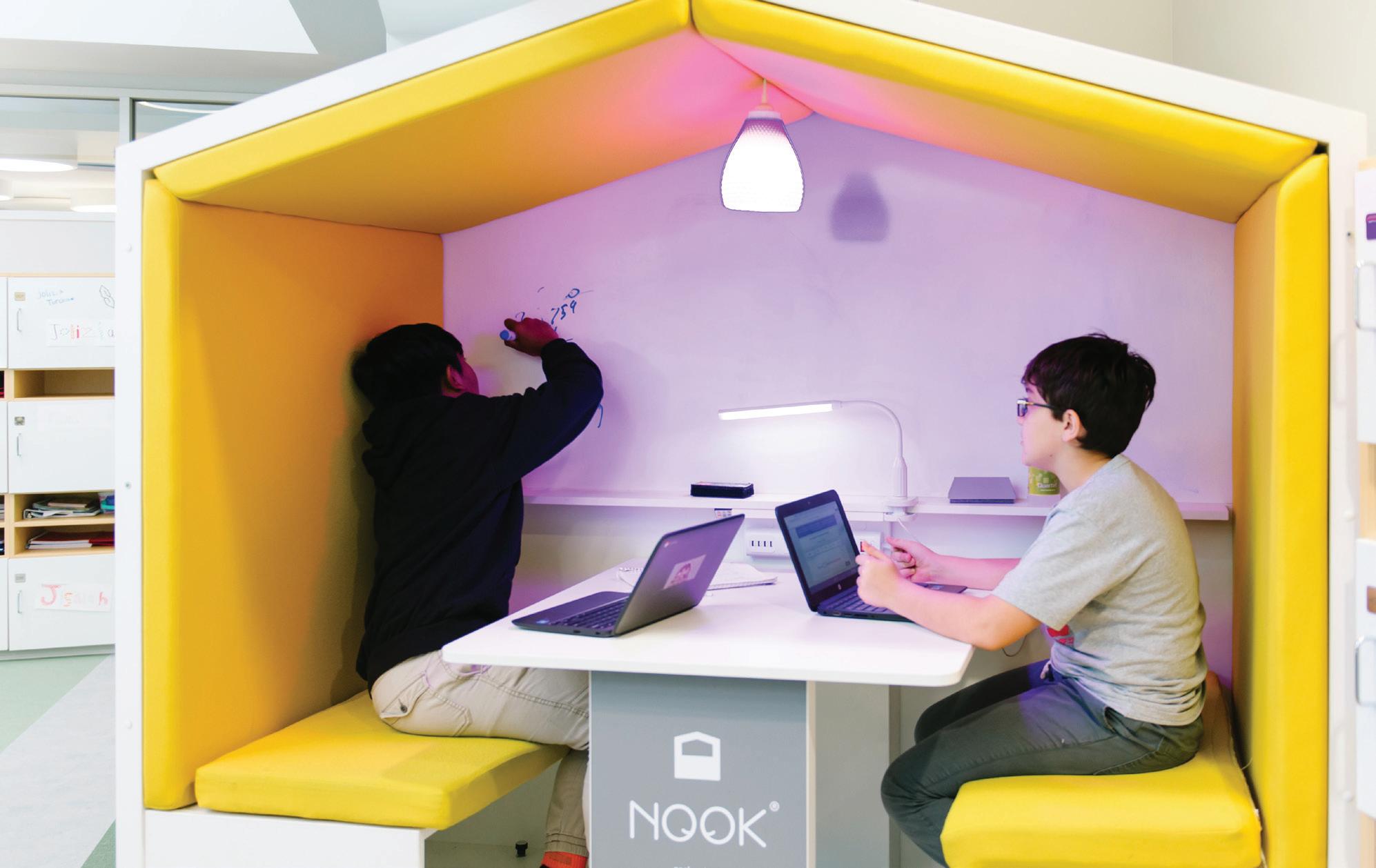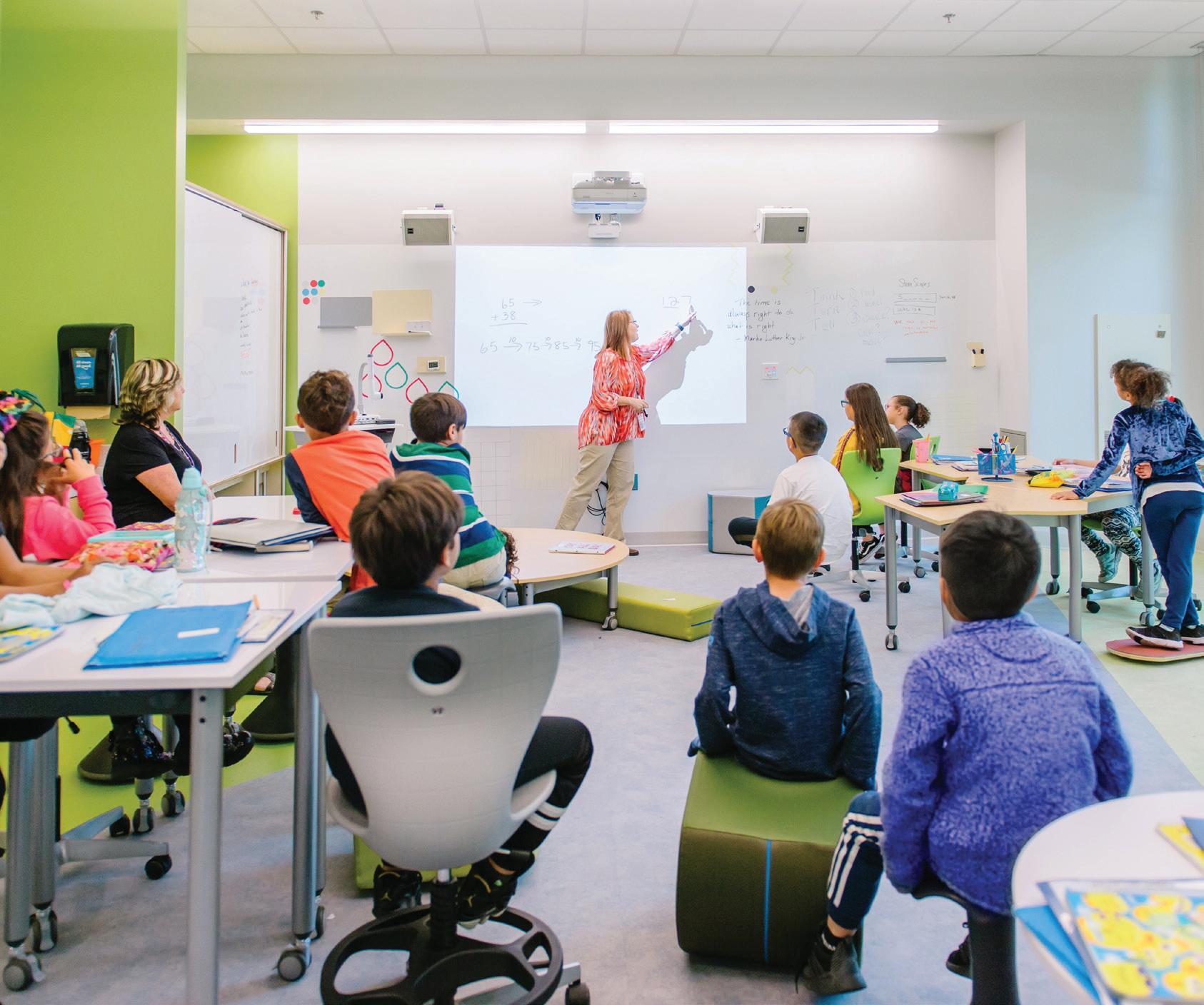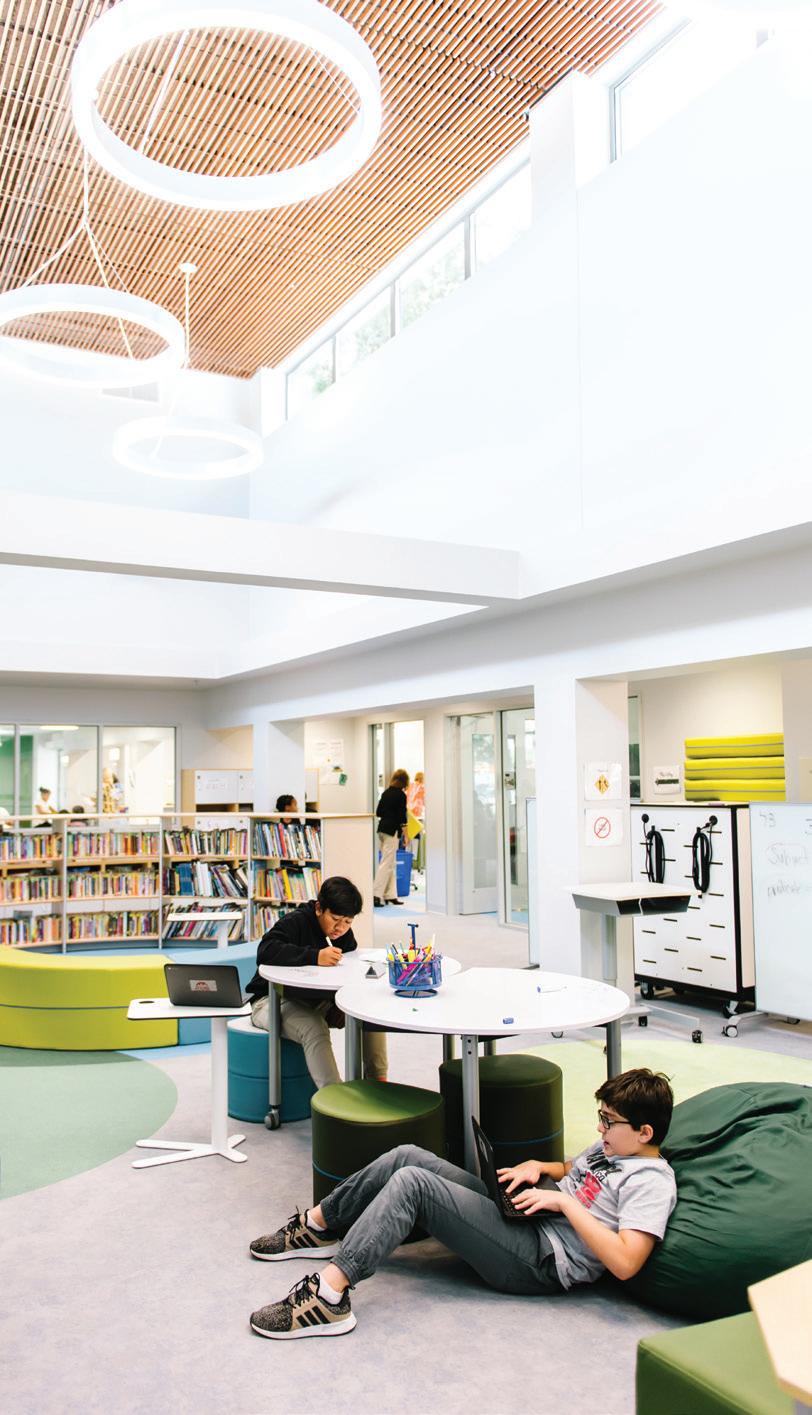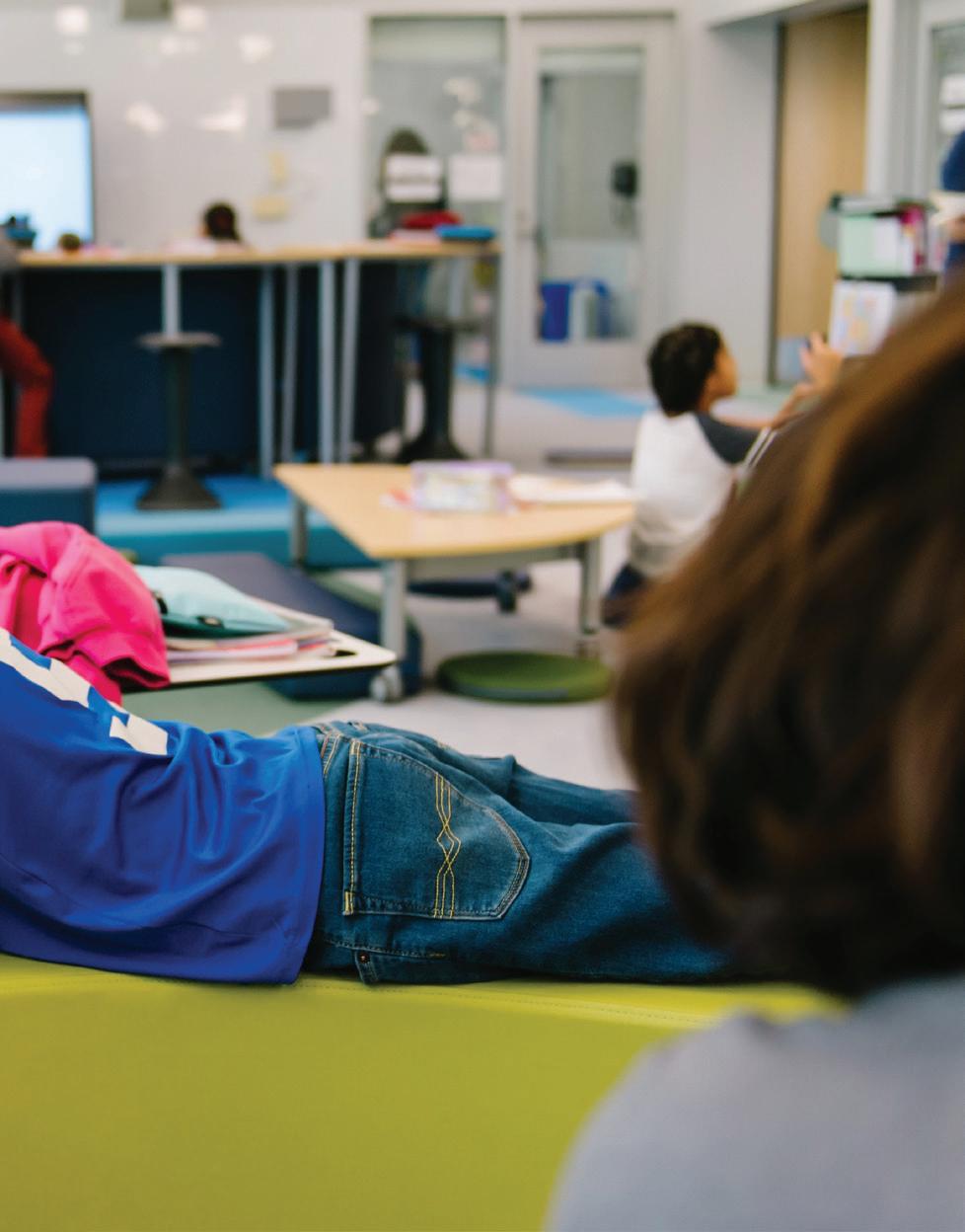
10 minute read
Joy to the world
Jay Litman AIA, Jill Ackers and Jennifer Leyva from Fielding International explain how their company has reimagined a school for the needs of the modern age.
Eden Park’s Learning Community: more joy and more learning

What should modern learning look like in 2021 and beyond? It’s a question we have been asking ourselves for the last 15 years. We know the answer does not begin with the school building. It lies with our Fielding mantra, “We start with the child”. The child we are now contemplating will not be out of college and into the “real” world until the early 2040s. What will that world be like, and how do we ensure these future young adults are equipped with the durable skills needed for times that are so far ahead from now? What can we do to prepare this incoming generation to be successful and happy in the years to come?
We believe that for tomorrow’s children to find success in a wired, AI-driven, technocratic society, they must also have a solid grounding in the physical world. Our future schools must create a learning environment that fosters the development of critical human qualities and skills, such as patience, empathy, inquisitiveness, curiosity, collaboration, confidence, humour and critical thinking.
Developing a Learning Community It has been evident for many years now to all of us at Fielding International (FI) that the antiquated “cells and bells” school model can no longer support the development of the human skills, competencies and behaviours essential for young adults. To find success in the rapidly approaching AI-driven digital world of the mid-21st century, schools must prepare students to thrive in the Fourth Industrial Revolution. Much like the post-Covid-19 workplace has evolved, so too must our learning ecosystems by breaking free from traditional school schedules and reconsidering the boundaries of when learning, playing and socialisation occur. This new kind of collaborative teaching and mentorship has taken root in many of the schools we have designed over the last 18 years. Although the world has changed and become flatter and faster, schools have not. To support these changes, we conceived new design patterns and evolved the “neighbourhood” model into what we call a Learning Community. A Learning Community is a powerful ensemble of spaces. At its heart is a “Commons” for shared learning, which acts not only as a social heart but also the main venue for teaching and student-directed learning. The learning begins in the flexible Learning Commons, but surrounding it is a collection of discrete learning studios, small group and seminar rooms, which provide a variety of breakout spaces for teachers to personalise learning through a workshop model and to respond to individual needs. This represents a paradigm shift from the neighbourhood model, which is no longer viable to enable learner independence, resilience when making decisions, or engaging in sustained enquiry through problem-solving. Educators work in cross-functional teams to support learners’ growth collectively. Therefore, no one teacher owns a classroom. Teachers and children select appropriate spaces that best suit their learning or best elicit the types of thinking they are engaged in at the time. To support these spaces’ planned use, teachers now have a collaborative workspace where real-time professional development can occur. With the departure of corridors and autonomous classrooms has come new freedom in the language of school design. The shift in pedagogical programming has meant that the fundamental form of a school building has shifted from a rectilinear office building to something far more organic. A new school must be far more than a place to work and learn. It is also where we begin to build relationships with other people, find out how we work collaboratively, develop a sense of ourselves and discover how we as individuals fit into our world and society. At FI, we believe that it takes an entire community to educate a child. Our Learning Community’s systems are grounded in best practices for cognitive development and learning while proactively being focused on well-being, digital innovation and problem-solving. Sustainable schools must be adaptable on many levels. These new spaces are cultural ecosystems that transcend the traditional notion of school because they are based on interactions, relationships and meaningful curriculum design. An excellent example of this type of reimagined environment exists at Eden Park, an elementary school in Cranston, Rhode Island, USA.
Eden Park Elementary Cranston Public Schools (CPS) is an average-sized American school district of 22 schools that serve an economically and ethnically diverse population. Cranston is the second-largest city in Rhode Island and, typical of most American cities, most of its schools were built in the 1950s and ’60s. Despite the advanced age of many schools in the District, CPS leadership proclaimed that “we must go beyond warm, safe and dry”. Fielding had just completed a comprehensive school facility plan, reinventing and reimagining Cranston’s schools for the next 20 years and beyond. When approached by CPS district leadership to identify a potential “Pathfinder” or demonstration project, Eden Park presented a golden opportunity. In addition to a forward-thinking School Superintendent and District administration, Eden Park has a very progressive principal and a teaching staff that was ready to reimagine and redefine their roles as teachers by letting go of the assumptions of what used to be school. They have fully embraced new instructional methods, real-time collaboration and a flexible schedule to match their learning environments’ flexibility. Although limited in scope, the Eden Park project entailed a total transformation of the 12,000-square-foot (1,115-square-metre) west wing, of this 68-year-old, K-5 elementary school, including a new main entrance. We demolished everything back to the original structural frame and then rebuilt from the ground up. When designing this Eden Park wing as a Learning Community, as we do with any FI learning community, our focus was to craft an ensemble of student-centred collaborative spaces. Moving away from the model of one teacher–one room–and sole care of one group of students, we create an environment that supports learner-agency, transparent technology, and supports a wide variety of teaching and learning situations. These situations range from small group and independent study to whole group instruction or one-on-one with a teacher. FI spaces also emphasise the importance of teacher collaboration and include workspaces that allow teachers to work both independently and as a team. The adoption of the Learning Community model at Eden Park allows for more flexibility and variety in day-to-day learning activities. The old corridor was absorbed into the Learning Commons, leading to an agile space that supports multiple ways of learning, and multiple groups of learners. This type of shared commons creates a diffuse distribution of students and collaborative work areas. Transparency between the Learning Studios and the Commons facilitates interdisciplinary learning activities for kids, adults and folks who use these spaces for special services.

TIDY. IN 3D.

If you’re designing a learning space and want to integrate Gratnells storage, you can now nd key products as models in the SketchUp 3D Warehouse.
Visit 3dwarehouse.sketchup.com and search for Gratnells.
T: +44 (0)1279 401550 E: mail@gratnells.com gratnells.com
Measuring success Teachers’ professional development is embedded into the fabric of our work. Cranston is involved in ongoing professional development, which includes a three-year teacher coaching programme. Teachers develop mastery in a collaborative, interdisciplinary, project-based curriculum. Each year, the programme becomes more student-centred, with learners identifying and defining problems and projects themselves by year three. The results are in: at the 3rd–5th Grade Learning Community at Eden Park Elementary, the first completed, the level of engagement, personalisation and physical comfort has reduced absences, seen a huge drop in disciplinary issues and all but eliminated the need for specialised isolation and decompression rooms for students with special needs – instead, they are thriving within a suite of spaces shared by everyone in their learning community. The result is more learning, more joy and less space required. In March, when schools shut down for Covid-19, Eden Park Elementary found that students who had been in a Fielding International-designed Learning Community were more successful when setting up their at-home learning environments. Teachers found these students could work more independently than those who were not used to learning environments that provided freedom and agency – where learners have to make an independent choice over the type of space to work in based on the kind of learning and thinking they are engaging in. Our team designed a new exterior envelope with a highly insulated rain-screen system that uses a sustainable fibre cement panel cladding. All the new windows were sized to bring in the maximum amount of natural light, and operable with screens to allow for the ventilation of fresh air. Our consulting engineers, Creative Environment Corp., designed the mechanical systems to deliver dedicated, Merv 13-filtered outdoor air to each space through an energy recovery ventilator (ERV).
The multi-sensory room is a space where children can unwind mentally and emotionally.





The heating, ventilation and air-conditioning (HVAC) system is controlled by a building management system (BMS) that enables pre- and post-purge occupancy of indoor air. Many of these features have just been recommended by a joint US Environmental Protection Agency/Energy Star Task Force on preventing the spread of Covid-19 in schools. We mention this here because this level of performance will now be part of our post- Covid-19 reality for all new schools. Eden Park’s furnishings were carefully selected for this new way of learning and teaching. The space was fitted out with agile and flexible pieces, engaging the learner to be autonomous and create their own learning environment. Therefore, the furniture is intentionally selected to reinforce the pedagogy, not the other way around. Soft, sturdy building blocks in various shapes, sizes and colours allow users to explore their learning community and find new ways to work together rather than being tied to a desk and a chair. The beauty of play and movement is that it gives children the chance to achieve the necessary levels of physical activity in a way that is motivated by the fun of it. Developing a pattern of being active will stay with a child because it teaches us how we learn through our whole body and not just our minds. Studies have shown that when our bodies are engaged physically, our minds are more alert and prepared. This allows the children to feel a part of their community and to respect the space they share with their teachers and peers. There are valuable lessons to be learned here, which should be repeated elsewhere worldwide because we are at a pivotal moment of change. This is a turning point in history. The reimagination of learning spaces, along with the critical issues of health and well-being, will play a vital role in the development of this new, holistic, sustainable design strategy for our schools. Only this kind of approach can address the challenges posed by the broad spectrum of ecological, energy, educational health, and social issues humans now face. The Eden Park project proves that when a school is designed to support the whole student at every level, it will prepare them and their teachers for the twentyfirst century and show them a new vision of the future through the joy of learning.










